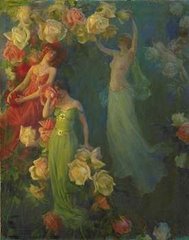 This painting perfectly shows how pink lotus (Nelumbo nucifera) possesses an amazing ability to flourish in a variety of environments ranging from clear ponds to muddy marshes. How can the flowers be so pure and delicate above the waters while its roots are in the mud. It's mystical, like a symbol, that something good can come after darkness. And it's true lotus symbolizes purity, beauty, majesty, grace, fertility, wealth, richness, knowledge and serenity Lotus is a sacred flower for Hindus and Buddhists.
This painting perfectly shows how pink lotus (Nelumbo nucifera) possesses an amazing ability to flourish in a variety of environments ranging from clear ponds to muddy marshes. How can the flowers be so pure and delicate above the waters while its roots are in the mud. It's mystical, like a symbol, that something good can come after darkness. And it's true lotus symbolizes purity, beauty, majesty, grace, fertility, wealth, richness, knowledge and serenity Lotus is a sacred flower for Hindus and Buddhists. Lotus is also one of the principal archetypal symbols used in yantras. Generally centered on the axis with its petals unfolding towards the circumference, it is the appropriate image to illustrate the unfolding of power of the divine essence. Lotus is a strong plant I found something real interesting, on March 30, 1951, lotus seeds of more than 2ooo years old were found in a muddy stratum under the Kemigawa Social Farm of Tokyo University. These seeds blossomed the next year, on July 18, 1952, and became known as the "oldest flower on earth." This lotus plant was called the "Ohga Lotus". How amazing that these seeds were able to grow again after 2000 years. You can read the article here.
Lotus is also one of the principal archetypal symbols used in yantras. Generally centered on the axis with its petals unfolding towards the circumference, it is the appropriate image to illustrate the unfolding of power of the divine essence. Lotus is a strong plant I found something real interesting, on March 30, 1951, lotus seeds of more than 2ooo years old were found in a muddy stratum under the Kemigawa Social Farm of Tokyo University. These seeds blossomed the next year, on July 18, 1952, and became known as the "oldest flower on earth." This lotus plant was called the "Ohga Lotus". How amazing that these seeds were able to grow again after 2000 years. You can read the article here.
 Called a 'lotus', the depictions of the floral symbol of Upper Egypt is actually known as a Nymphaea caerulea which is actually known today to be a (blue)water lily. This flower, along with the papyrus flower, was shown throughout Egypt in tombs and temples to symbolize the union of Upper and Lower Egypt. The perfume of this flower was not only pleasing to the Egyptians, but they saw it as healing as well. Scenes show women holding the water lily and people being offered the flower at parties, smelling its divine fragrance. Some people today believe that the Egyptians used this plant as a narcotic both for its healing qualities and as a recreational drug when soaked in wine, though this is a hotly debated topic.
Called a 'lotus', the depictions of the floral symbol of Upper Egypt is actually known as a Nymphaea caerulea which is actually known today to be a (blue)water lily. This flower, along with the papyrus flower, was shown throughout Egypt in tombs and temples to symbolize the union of Upper and Lower Egypt. The perfume of this flower was not only pleasing to the Egyptians, but they saw it as healing as well. Scenes show women holding the water lily and people being offered the flower at parties, smelling its divine fragrance. Some people today believe that the Egyptians used this plant as a narcotic both for its healing qualities and as a recreational drug when soaked in wine, though this is a hotly debated topic.  I just love to see this lovely flower and I had to find out how the absolute made of this flower would smell like. It's a very expensive absolute it cost around 6000 dollar a kilo. The first impression of this absolute wasn't what I expected, the smell wasn't flowery it was more earthy and peppery after I diluted at a 5% the scent was more pleasant it became more flowery with still the earthy scent in the background, I can detect a herbal scent as well. Lotus absolute doesn't smell like any other flower absolute I ever smelled before, it has an unique smell. I like to combine pink lotus with tuberose and jasmine especially jasmine sambac. It's also real nice with oak moss and a tiny bit of aldehyde C12 mna but this aldehyde overwhelms the composition real easy. I'm always curious about the aroma components of a flower so I googled and found an interesting article that speaks about the head space analysis of lotus.
I just love to see this lovely flower and I had to find out how the absolute made of this flower would smell like. It's a very expensive absolute it cost around 6000 dollar a kilo. The first impression of this absolute wasn't what I expected, the smell wasn't flowery it was more earthy and peppery after I diluted at a 5% the scent was more pleasant it became more flowery with still the earthy scent in the background, I can detect a herbal scent as well. Lotus absolute doesn't smell like any other flower absolute I ever smelled before, it has an unique smell. I like to combine pink lotus with tuberose and jasmine especially jasmine sambac. It's also real nice with oak moss and a tiny bit of aldehyde C12 mna but this aldehyde overwhelms the composition real easy. I'm always curious about the aroma components of a flower so I googled and found an interesting article that speaks about the head space analysis of lotus. The living flower contained the following components with the percentage written behind it:
Sabine 6%
para Dimethoxy benzene 18%
4-Terpineol 3%
alpha Terpineol 9%
cis Jasmone 0.1%
C15 Hydrocarbons 20.1%
However the picked flower contained the following components with the percentage:
sabine 12%
para Dimethoxy benzene 8%
4-Terpineol 1.5%
alpha Terpineol 1%
cis Jasmone 0%
C15 Hydrocarbons 30%
This shows that alpha terpineol which possesses a very floral odor decreases drastically from 9% in the living to 1% in the picked lotus blossom. Similarly, the character-donating component, para dimethoxy benzene, decreases markedly from 18% in the living lotus to 8% after picking. The cis jasmone disappeared totally. So maybe it would help to add some of these components to the absolute. If you are interested to read the article you can read it here.











8 comments:
This was fascinating !
I enjoyed it very much...
[and I just joined your group...hoping to learn so much more]
Hi Chaya, I'm glad you like the post and I already made you a full member of the group. See you there.
Jenny
I have also found that pink lotus (undiluted) seems to get prettier with age. A fresh vial seems too much for words - but aged it mellows - and it is pretty.
Blue lotus however, I find to be diabolically awful
Heather
Hi Heather,
O so it's the same like patchouli, this one seems also getting better after it aged, didn't know that about lotus. I never smelled blue lotus.
Hi there!
I am really interested doing a perfumers course. Does anyone know if there are short courses (1 week max) available in Europe?
Thanks!
Hi, I know Prodarom does courses
http://www.prodarom.fr/UK/gip-formation.htm
but this is a course of 9 months.
You can also do a course at home with Perfumersworld they have also a free course, just click on the 'courses' button and click next until you see:
FREE FOUNDATION COURSE
Than click until the page where you have to sign up for this course.
http://www.perfumersworld.com/
I also have a Yahoo group for perfumers this is a very active and friendly group, were you will get tons of information:
http://groups.yahoo.com/group/perfumemaking/
But when I'm right you just became a member there already, because I had the same question there
Good luck!
Hi Jenny Im wondering if you can help me out I'm after a perfume making short course thats in melbourne. I have no qualifications in this area? Thanks Dean
In Melbourne (Australia) there is this perfume house running courses and workshops. www.fleurage-natural-perfume.com.au Hope that's the right country for you. Cheers Rob
Post a Comment